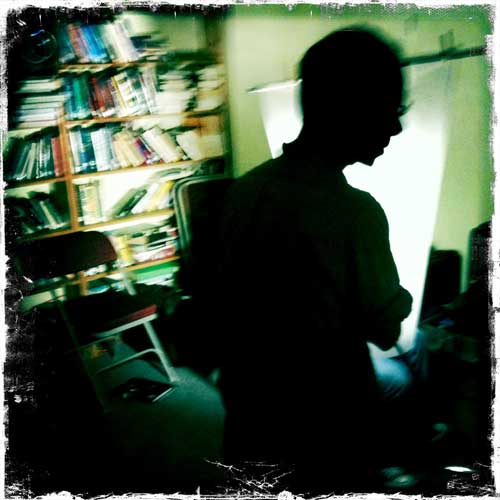Zachary Levy taught another solid 3-hour workshop this afternoon at Northwest Film Forum. I’ve had a fair bit of mostly self-taught experience with lighting, so I was curious to see how my technique stacked up. I picked up these great tips, as well as a raft of lingo that’s new to me. Armed with this info, I feel more confident that I can speak the language of lighting with other professionals. Which was totally worth the $35 workshop fee. Here’s the highlights (so to speak):
750 stand – a sturdy light stand that is more solid than standard light stands, perfect for supporting heavier fixtures such as the Arri 650 fresnel light that we were using today.
Power math – When arriving at a location, you need to do some simple math before you start plugging in lights, or you risk tripping a breaker halfway through the interview. Typical households in the US operate 15 amp circuits, at 120 volts. Professional lights like the Arri 650 list the wattage they consume in their name, which means the Arri 650 consumes 650 watts. Here’s the formula:
Watts divided by Volts = Amps.
So in our case with one 650 watt light + one 300 watt light, that means we’d do this math:
950 / 120 = 8 amps.
In this case, we know that we’re fine to run both of those lights on the same circuit, because 8 amps is only about half of the 15 amp maximum for the typical household. Commercial buildings typically support up to 20 amps per circuit. It’s important to remember that a circuit isn’t just the same plug outlet – it’s usually all the outlets in the same room, so you’ll need to run an extension cord (commonly called a stinger in film set lingo) to tap another circuit.
Striking – when turning on a powerful light on set, it’s common to alert everyone that a potentially blinding light is about to go on by yelling “striking” (as in striking a match).
Color bars – In interview situations, it’s common to use a field monitor to get a really good picture of what you’re getting while you’re getting it. And prior to every use, it’s good practice to calibrate the monitor quickly by displaying the camera’s color bars. It’s simple: switch to “blue only” mode, which turns the color bars all grey, then adjust the chroma, luminance, and brightness until the top of the bars most closely matches the bottom. For brightness, turn it up all the way, until you can see three short bars in the lower right. Then turn it down until the brightest of the bars is just barely visible. Bingo: you’re calibrated.
Just 5 stops – most prosumer video cameras see only about 5 stops of light between the brightest white and the blackest black. Our eye sees thousands of levels.
100 percent zebra – Zach recommends setting zebra stripes to 100 percent so that you can see where the 100 percent white is clipping, and use your eye to gauge the lesser levels, rather than setting zebra’s to kick in at 70 or 80 percent, because then you can’t tell the difference between 70 and 100.
Chair test – prior to the interview, make sure chair that will be used doesn’t squeek, rock or rotate. Obvious stuff, but easy to overlook and can kill a great moment in your interview if you don’t plan ahead.
Scrim – Red scrim is typically a double-strength scrim that cuts light by a full stop; green scrim is half-strength scrim that cuts light by a half stop.
C-47 – it’s not an airplane; it’s not a high explosive. It a fancy name for wooden clothes pins, used to attach gels and diffusion to c-stands.
Assume the position – it’s a convention to position the interviewer so that they are close to the camera between the camera and the key light. This way, the subject is looking more into the light. Also, position interviewee to one side of the frame – not in the middle. Then, you can position the next interviewee on the other side, and they’ll intercut better (not always in same place). Reframe during questions. Keep camera on sticks, but don’t lock it down fully – be ready to follow interviewee.
Pack black garbage bags – and gaffer’s tape to mask out unwanted window light when you’re trying to fully control the lighting for an interview.
Clothing – avoid pattern shirts on interview subjects (because it causes nasty moiree pattern on video). White is also bad – it’s too hard to lighten face relative to shirt.

Pingback: Lighting research « My Blog